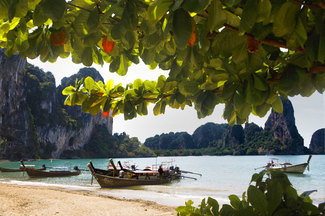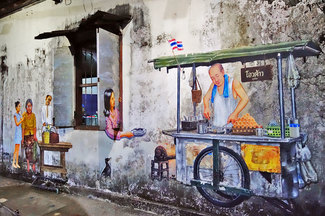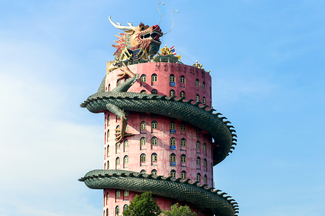WAT PA MAHA CHEDI KAEW

Upcycling can be defined as the reuse of discarded objects and materials to create something of higher quality or value than the original. The temple known as Wat Pa Maha Chedi Kaeaw, in the Khun Han district of Sisaket, is a shining example of upcycling that has involved the entire community, working with the temple’s monks, to produce a shimmering edifice of glass that is visually stunning and a shining example of what can be done with millions of used beer bottles and ingenuity born of necessity.

A temple of glass
In 1984, the senior monk, Phra Khru Vivek Dharmajahn, known to his followers as Luang Pu Lot, and his fellow monks at Wat Larn Kuad grew tired of the growing litter problem in Sisaket, which lies near to the border with Cambodia, and decided to initiate a programme to promote recycling to deal with the large number of discarded beer bottles that littered the landscape.
The monks put out the word and asked local residents to bring them empty their empty bottles, green Heineken bottles and brown Chang ones. The response was immediate and overwhelming and so began a building programme that has so far produced an elegant ordination hall facing a pond, an impressive wihan(a shrine hall that contains images of the Buddha and an assembly point for monks and worshippers) with a chedi, (a relic chamber) reaching to the tree tops, crematorium, bell tower, sleeping quarters, water towers and public toilets, somewhere in the region of 20 buildings to date.
All the bottles are placed into the concrete structures of the buildings in a variety of design patterns to create a striking visual spectacle that is a testament to the power of faith working for the greater good. And, the great thing about glass bottles is they do not fade with time, create distinctive patterns of reflected light and are easy to keep clean. Even the bottle tops are made use of to form wonderful mosaics of the Buddha in the interior areas.
The name วัดป่ามหาเจดีย์แก้ว, Wat Pa Maha Chedi Kaeaw, translates to something like Wilderness Temple of the Great Glass Pagoda, but is often locally referred to as the Million Bottle Temple, having used more than 1.5 million bottles so far in the construction of the temple complex. As the supply of bottles is constant the monks intend to continue constructing more buildings as long as people keep drinking beer.
In 1963 Alfred Heineken came up with the idea of an eco-friendly ‘brick that holds beer’ bottle design, brought to fruition by the Dutch architect John Habraken. The idea first occurred to Mr Heineken as a result of trip to the Caribbean where he saw beaches littered with discarded beer bottles at a time when suitable building materials were scarce. The WOBO (world bottle), as it came to be called, was way ahead of its time and deemed too radical and the project ultimately stalled.
 The Wobo
The Wobo
A brief revival of the concept in 1975 resulted in the collaboration of Habraken again and designer Rinus van den Burg, but once more support for the idea waned and the proposed building projects remained on the drawing board.
 Heineken and Chang, making merit
Heineken and Chang, making merit
Although unaware of Heineken’s avant-gard attempts at upcycling, the enterprising monks at Wat Pa Maha Chedi Kaeaw nevertheless saw the potential of waste put to a positive and eco-friendly use and in the process built a temple which is not only aesthetically pleasing on the eye but a marvel of adaptation to address a contemporary concern that has a profound impact on the way we live our lives.










of collaborative energy




Before proceeding to use the website please carefully ready our Terms and Policies
I accept Diwerent's Terms and Conditions and Privacy Policy













